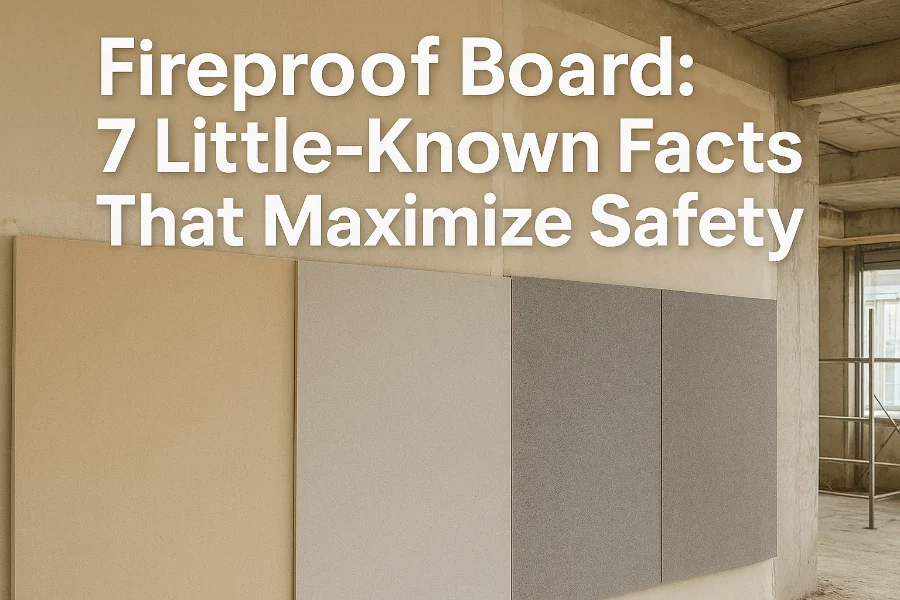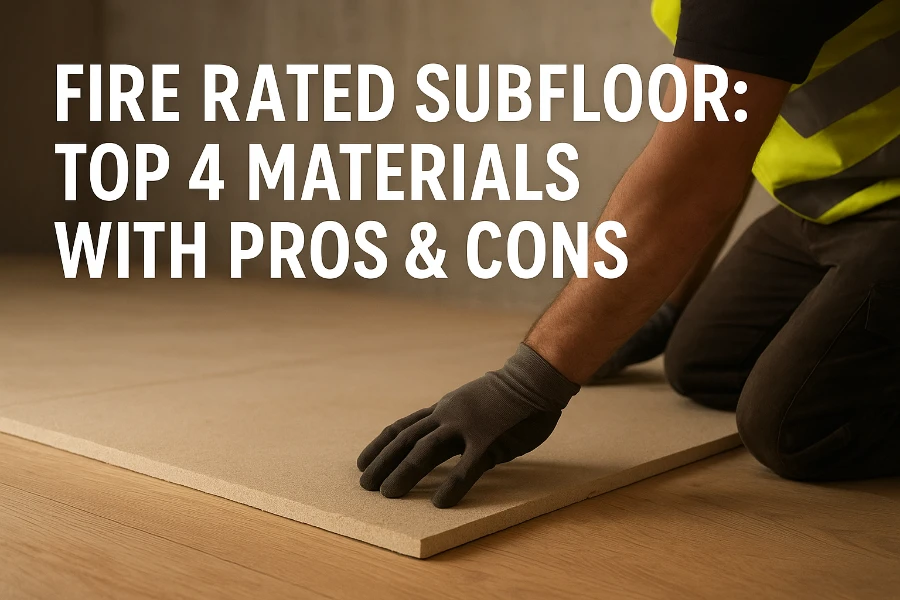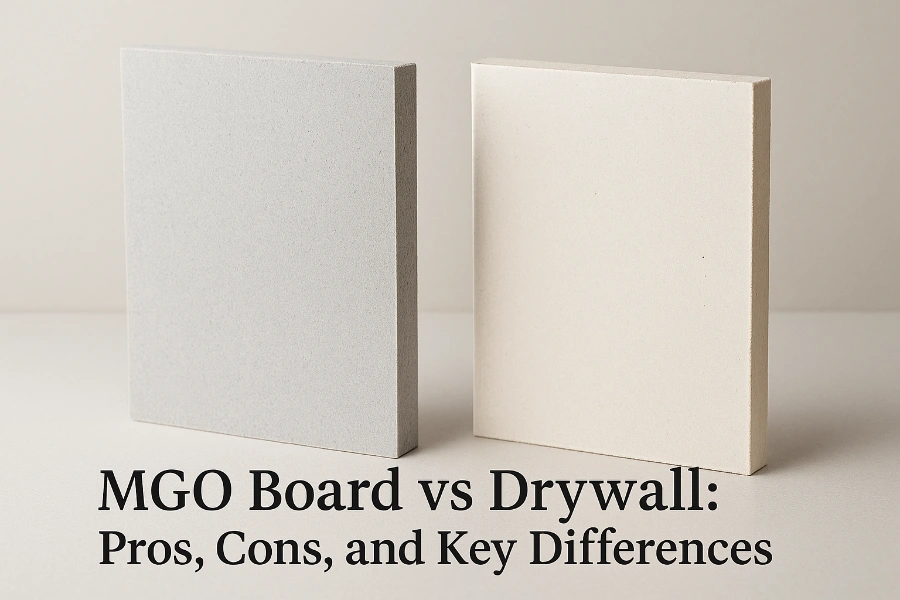Table of Contents
Introduction
Fire safety is one of the most critical aspects of modern construction. Fires can cause severe property damage, disrupt operations, and, most importantly, put human lives at risk. To mitigate these hazards, using the right building materials is essential. Among these, fireproof boards play a key role by slowing the spread of flames, maintaining structural integrity, and providing occupants with crucial evacuation time.
While many builders and designers are familiar with common fireproof boards, such as gypsum, cement, and magnesium oxide (MgO) boards, there are several lesser-known facts about these materials that can significantly impact building safety. Understanding these details can help architects, contractors, and property owners make informed decisions that maximize fire protection and long-term performance.
This article explores seven little-known facts about fireproof boards that every construction professional should know. These insights go beyond basic fire ratings, highlighting hidden factors that influence real-world safety outcomes.
1. Fire Resistance Is More Than Just a Rating
Most people evaluate fireproof boards primarily based on their published fire ratings, such as a 1-hour or 2-hour fire resistance classification. However, the actual effectiveness of a board in a fire scenario depends on several additional factors:
-
Material Thickness and Composition: Two boards with the same rating can perform differently depending on thickness and the specific materials used. For example, gypsum boards rely on chemically bound water to slow fire spread, while cement and MgO boards resist heat through mineral stability.
-
Installation Quality: Improperly sealed joints, gaps around edges, or inadequate fasteners can compromise the board’s fire-resistance performance. Even a high-rated board may fail to protect the structure if not installed correctly.
-
Environmental Conditions: Boards exposed to high humidity or moisture can lose some of their fire-resisting capabilities, especially in the case of gypsum boards. Cement and MgO boards tend to maintain performance better under such conditions.
Understanding that fire resistance is influenced by both the material itself and the installation environment is crucial. Selecting a board with a high fire rating is only the first step; ensuring proper installation, correct thickness, and compatibility with environmental conditions determines its real-world effectiveness.
2. Moisture and Fire Safety Go Hand in Hand
While fire resistance is the primary function of fireproof boards, moisture exposure can significantly affect their performance. Many construction professionals underestimate how humidity and water contact can compromise a board’s ability to resist flames.
-
Gypsum Boards: Gypsum boards are highly effective in dry conditions, but their fire resistance can diminish when exposed to high humidity or direct moisture. The chemically bound water that helps slow fire spread can be partially lost over time, reducing their effectiveness during a fire. In bathrooms, basements, or areas prone to leaks, gypsum boards may warp, soften, or even deteriorate.
-
Cement Boards: Cement boards are more resistant to moisture and maintain structural integrity under wet conditions. Their mineral composition allows them to withstand high humidity without significant loss of fire-resisting properties. This makes cement boards suitable for kitchens, exterior walls, and wet commercial spaces.
-
MgO Boards: Magnesium oxide boards offer a unique balance of fire resistance and moisture tolerance. They retain structural stability even in humid or damp environments, making them ideal for areas where both fire safety and moisture resistance are essential. Unlike gypsum, MgO boards do not lose effectiveness when exposed to moderate water or condensation.
-
Installation Considerations: Proper sealing and edge treatment are critical in high-humidity areas. Even moisture-resistant boards can underperform if joints are left unsealed or if water penetrates through gaps. Using moisture barriers, sealing tapes, and correct fasteners ensures that fireproof boards maintain their protective properties over time.
Recognizing the interplay between moisture and fire resistance helps architects and builders choose the right board for each application. Selecting a board that can withstand both environmental stress and heat ensures reliable protection for occupants and reduces the risk of costly repairs or replacements.
3. Not All Fireproof Boards Are Environmentally Safe
Beyond fire resistance, the environmental impact and indoor safety of fireproof boards are increasingly important considerations in modern construction. Some boards may release harmful substances over time, affecting indoor air quality and occupant health.
-
Gypsum Boards: Standard gypsum boards are largely inert and generally safe for indoor use. However, certain specialty gypsum products may contain chemical additives or binders that emit volatile organic compounds (VOCs), particularly when exposed to heat or humidity. While usually minimal, these emissions can affect sensitive populations or poorly ventilated spaces.
-
Cement Boards: Cement boards are stable and non-combustible, making them safe in terms of emissions. Their environmental footprint is moderate, as production requires significant energy and raw materials. However, they generally do not release harmful gases during normal use, making them a reliable choice for interior and exterior applications.
-
MgO Boards: Magnesium oxide boards are composed primarily of mineral-based compounds and are naturally non-toxic. They do not emit harmful gases even when exposed to high heat or moisture, making them suitable for high-occupancy areas such as offices, schools, and hospitals. Additionally, MgO boards can often be manufactured with lower energy consumption and abundant raw materials, contributing to a reduced carbon footprint over the building’s lifecycle.
-
Indoor Air Quality: Choosing fireproof boards that minimize emissions is crucial for maintaining healthy indoor environments. Low-VOC, non-toxic boards help prevent long-term exposure to irritants, contributing to occupant comfort and wellness.
Selecting fireproof boards with environmentally safe compositions ensures that buildings are not only fire-resistant but also healthier for occupants. By considering both fire protection and indoor air quality, designers and builders can create spaces that are safe, sustainable, and compliant with modern building standards.

4. Weight Can Affect Safety During Fire
The weight of a fireproof board is more than just a construction convenience—it can directly impact structural safety during a fire. Selecting the appropriate weight ensures that the board maintains its integrity while not overloading the supporting framework.
-
Lightweight Boards: Gypsum boards are light, which simplifies handling and installation. However, in large-scale or high-rise structures, excessively lightweight boards may lack the rigidity required to withstand fire-induced stress, potentially leading to deformation or failure under heat.
-
Heavy Boards: Cement boards provide enhanced stability and impact resistance due to their weight and density. During a fire, heavier boards are less likely to warp quickly, but the additional load can place stress on walls and supports. If not properly designed, this weight could contribute to structural hazards, especially if parts of the building are already compromised.
-
Balanced Weight: Magnesium oxide boards strike a balance between lightness and strength. They offer sufficient rigidity to resist warping under high temperatures while remaining manageable for installation. This balance ensures both safety and construction efficiency, particularly in multi-story buildings or areas with strict load constraints.
-
Structural Design Considerations: Architects and engineers must factor in board weight when planning wall assemblies, partitions, or ceilings. Proper framing, fasteners, and joint reinforcement are essential to prevent collapse or detachment during a fire. Boards that are too heavy or too light can compromise safety, regardless of their fire rating.
Understanding the relationship between weight and fire safety allows builders to make informed decisions that protect occupants while maintaining structural integrity. Choosing boards with an optimal weight profile ensures they perform effectively when it matters most.
5. Fireproof Boards Differ Greatly in Impact Resistance
While fire resistance is the primary purpose of fireproof boards, their ability to withstand physical impacts during a fire or everyday use is often overlooked. Impact resistance contributes to the board’s overall effectiveness and longevity, particularly in high-traffic or industrial environments.
-
Gypsum Boards: Gypsum boards are relatively brittle and can crack or crumble under moderate impact. During a fire, falling debris or rapid heat expansion may compromise their structural integrity, reducing their ability to contain flames and protect occupants. Gypsum boards are best suited for low-traffic residential interiors where mechanical stress is minimal.
-
Cement Boards: Cement boards are dense and highly durable, providing strong impact resistance. They can tolerate heavy loads and maintain performance even when subjected to bumps, knocks, or debris. This makes them suitable for commercial spaces, exterior walls, and areas prone to mechanical stress.
-
MgO Boards: Magnesium oxide boards combine both rigidity and toughness. They resist cracking under impact while retaining excellent fire resistance. MgO boards are particularly advantageous in environments where both mechanical durability and fire safety are critical, such as industrial facilities, schools, or public buildings.
-
Installation and Handling: Even high-impact-resistant boards can fail if mishandled during installation. Proper cutting, mounting, and edge reinforcement help ensure that the board performs as intended under both fire and mechanical stress.
Understanding impact resistance helps architects and builders select boards that maintain structural integrity in real-world conditions, not just in laboratory fire tests. Boards that resist both fire and mechanical stress offer greater protection for occupants and reduce long-term maintenance costs.
6. Proper Certification Is Critical — But Often Overlooked
One of the least appreciated aspects of fireproof boards is the importance of certification. Fire ratings alone do not guarantee real-world performance, and not all products meet recognized safety standards. Ensuring proper certification is essential for both compliance and building safety.
-
Regional Standards: Different countries and regions have specific fire safety codes, such as UL (Underwriters Laboratories) in the U.S., EN (European Norms) in Europe, and GB standards in China. A board certified in one region may not automatically comply with another’s regulations. Understanding which certifications apply to your project is crucial.
-
Independent Testing: Reliable fireproof boards undergo rigorous testing for flame spread, heat insulation, smoke development, and sometimes mechanical durability. Independent lab certification ensures that the board performs consistently under controlled conditions. Boards lacking credible certification may not deliver the advertised fire resistance.
-
Installation Matters: Even certified boards can underperform if installed incorrectly. Certifications often assume proper installation methods are followed, including joint sealing, fastener spacing, and edge treatments. Builders must adhere to manufacturer guidelines to fully realize the board’s rated protection.
-
Holistic Safety Standards: Modern certifications increasingly consider additional factors beyond flame resistance, such as environmental health, indoor air quality, and structural integrity under stress. Choosing boards that meet comprehensive standards ensures safer buildings and simplifies approval processes during inspections.
Proper certification provides confidence that a fireproof board will function as intended, protecting both occupants and property. Overlooking this factor can lead to unexpected hazards, compliance issues, and costly retrofits. For architects and contractors, verifying certification is a critical step in responsible fire-safe design.
7. Fireproof Boards Can Contribute to Insurance Savings
Many building owners and contractors overlook a subtle but important benefit of using fireproof boards: insurance savings. High-quality fire-resistant materials can reduce the risk of fire-related claims, which may result in lower premiums for property and casualty insurance.
-
Risk Reduction: Insurance companies evaluate fire risk when calculating premiums. Buildings constructed with certified fireproof boards are less likely to suffer catastrophic damage in a fire, lowering the insurer’s potential liability. This risk reduction can translate into tangible financial benefits over time.
-
Compliance and Incentives: Using boards that meet recognized fire safety standards can simplify inspections and regulatory approvals. Some insurers provide additional discounts for buildings that exceed minimum fire safety requirements, rewarding owners who invest in superior materials.
-
Long-Term Savings: Beyond initial insurance costs, durable fireproof boards reduce repair and replacement needs after minor fire incidents. Materials that maintain structural integrity and resist heat damage can help minimize downtime, cleanup, and restoration expenses.
-
Strategic Selection: While initial costs for premium boards may be higher, the potential reduction in insurance premiums and post-fire expenses often offsets the upfront investment. Considering both construction quality and financial incentives provides a more comprehensive view of cost-effectiveness.
Incorporating fireproof boards into a building’s design is not just about safety—it can also make financial sense. By understanding the connection between material performance and insurance considerations, architects, builders, and property owners can maximize both protection and long-term savings.
Conclusion
Fireproof boards are a critical component of modern construction, offering protection that goes beyond standard building materials. Understanding their performance involves more than just reviewing fire ratings—factors such as moisture resistance, impact durability, environmental safety, weight, certification, and even potential insurance benefits play crucial roles in real-world applications.
Selecting the right fireproof board requires a comprehensive evaluation of both technical and practical considerations. Architects, builders, and property owners should assess materials not only for their advertised fire ratings but also for their long-term performance in real-world conditions. Proper installation, adherence to safety standards, and attention to environmental and structural factors are equally important.
Ultimately, informed choices in fireproof board selection enhance occupant safety, preserve property, and may even provide financial benefits. As construction practices evolve toward safer and more sustainable solutions, incorporating fireproof boards effectively ensures that buildings are resilient, reliable, and prepared for potential fire hazards.
Still have questions or want expert guidance on choosing the right fireproof board for your project? Contact us today and ensure your building is safe, compliant, and built to last.
Discover the top 4 fire rated subfloor materials with pros and cons. Learn which subfloor offers the best fire resistance, durability, and long-term value.
How to choose a reliable MGO board supplier: discover key merits of suppliers and magnesium oxide boards for safe, durable, and eco-friendly construction.
Compare MGO board vs drywall to understand their pros, cons, and key differences. Discover which wall material suits your project best.




